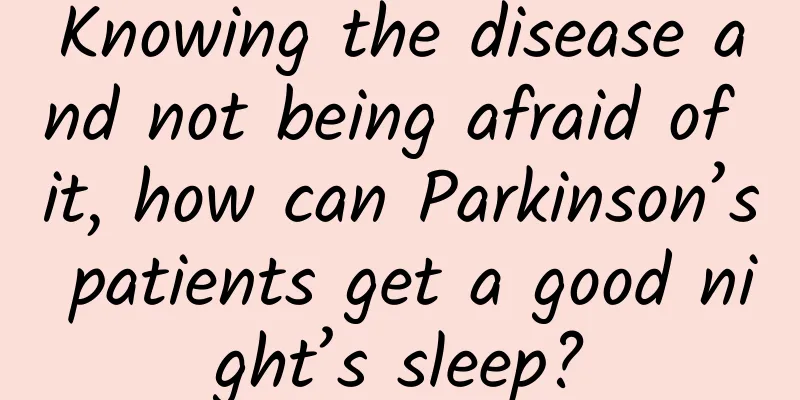Knowing the disease and not being afraid of it, how can Parkinson’s patients get a good night’s sleep?

|
Author: Li Fang China Rehabilitation Research Center Beijing Boai Hospital Reviewer: Fang Boyan, Chief Physician, Parkinson's Medical Center, Beijing Rehabilitation Hospital, Capital Medical University Figure 1 Copyright image, no permission to reprint Parkinson's disease (PD), also known as tremor paralysis, is a disease common in middle-aged and elderly people. Typical manifestations are bradykinesia, body stiffness, and sometimes tremors. It is common for the thumb and index finger to shake like a pill. In addition to motor symptoms such as bradykinesia, Parkinson's disease patients have many non-motor symptoms, which often occur earlier than motor symptoms. Sleep disorders are one of the common non-motor symptoms of Parkinson's disease, which accompany the disease throughout the course and may also appear before the movement disorders of Parkinson's disease. So, what types of sleep disorders do Parkinson's patients have? The sleep disorders of these patients mainly include insomnia, rapid eye movement sleep behavior disorder, restless legs syndrome, excessive daytime sleepiness, and sleep-disordered breathing. The same patient may have multiple sleep disorders at the same time, or different sleep disorders at different times. Now that we know the main types of sleep disorders in Parkinson's patients, let's talk about how Parkinson's patients with various sleep disorders can get a good night's sleep. 1. Insomnia (1) Clinical manifestations It usually manifests as difficulty falling asleep, frequent awakenings or early awakenings, which may occur in 25% to 80% of Parkinson's disease patients. Figure 2 Copyright image, no permission to reprint (2) Treatment recommendations It is recommended to identify the causes of insomnia and treat them in a tiered manner. If insomnia is associated with worsening of Parkinson's disease motor symptoms at night or nocturnal end-of-dose phenomenon, the dopamine treatment regimen should be optimized first, such as adding levodopa controlled-release agents before bedtime or adding long-acting dopamine receptor agonists (such as rotigotine transdermal patches) during the day. If insomnia is related to the adverse effects of anti-Parkinson's disease drugs, the time of taking the drugs should be adjusted to avoid or reduce the adverse effects of the drugs. For example, it is recommended to take selegiline in the morning or at noon, and take amantadine before 4 pm to reduce the adverse effects of the drugs on sleep; or gradually reduce or stop taking anti-Parkinson's disease drugs that affect sleep. If accompanied by non-motor symptoms such as depression or anxiety, antidepressant or anti-anxiety drugs can be added. If insomnia still cannot be improved by the above measures, sedatives, hypnotics, melatonin, etc. can be added. The above medication recommendations are for reference only. Please use the medication under the guidance of a specialist physician. (3) Life Advice ①First of all, you should pay attention to regular work and rest, sleep and rest on time, eat a light and balanced diet, and try to avoid drinking coffee, tea and other drinks that can easily make people excited in the afternoon. ② Do appropriate exercise during the day, and pay special attention to increasing the time spent in the sun. ③ When you have insomnia, you can try meditation and intentional imagination to divert your attention and not focus too much on insomnia. Keep your body and mind relaxed and breathe slowly and relaxedly to help you fall asleep. 2. Rapid eye movement sleep behavior disorder (1) Clinical manifestations It usually manifests as abnormal behaviors in dreams, such as simple limb twisting, or complex movements such as kicking and punching, abnormal postures, vocalizations (speaking or shouting), or dreams of being attacked, fighting or arguing with others, etc. 19% to 70% of Parkinson's patients may experience these abnormal behaviors in the early stages of the disease. (2) Treatment recommendations It is recommended to identify and remove medication factors that may cause or aggravate symptoms. Withdrawal from antidepressants, monoamine oxidase inhibitors, alcohol, or hypnotic drugs may aggravate REM sleep behavior disorder. Melatonin and clonazepam can be used, but clonazepam may increase the risk of falls. (3) Life Advice ①This type of Parkinson's disease patients need to establish a safe sleeping environment to avoid injury. ②Pay attention to a light diet and balanced nutrition. Try to avoid drinking coffee, tea and other stimulating drinks, and eating mutton, leeks and other foods that generate yang energy. 3. Restless Legs Syndrome (1) Clinical manifestations Patients often feel discomfort or tingling in their limbs, and thus often have the urge to move their limbs. These feelings or behaviors often occur at night, affecting sleep or causing fragmented sleep, thus interfering with sleep quality. About 15% of Parkinson's disease patients have restless legs syndrome. Figure 3 Copyright image, no permission to reprint (2) Treatment recommendations First, stop taking drugs that may induce or aggravate restless legs syndrome, and rule out other possible causes, such as iron deficiency anemia, renal insufficiency, diabetes, metabolic disorders and other diseases. The preferred treatment drugs are dopamine receptor agonists or low-dose compound levodopa and other drugs. 4. Excessive daytime sleepiness (1) Clinical manifestations The patient is unable to maintain a state of wakefulness and alertness during daytime awakenings, resulting in uncontrollable or unconscious sleep at inappropriate times. 21% to 76% of Parkinson's disease patients may experience excessive daytime sleepiness. Figure 4 Copyright image, no permission to reprint (2) Treatment recommendations To improve the symptoms of excessive daytime sleepiness, you first need to identify the possible causes of excessive daytime sleepiness. If the patient becomes drowsy after taking each medication, it may be related to medication factors, and the medication can be adjusted under the guidance of a specialist. For example, the dose and time of taking compound levodopa can be adjusted; antihistamines, benzodiazepines, and other antidepressants with sedative effects can be reduced or discontinued. If it is caused by insomnia at night, accompanied by sleep breathing disorders or depression, appropriate treatment should be carried out, and modafinil can also be used to promote wakefulness. (3) Life Advice ①Parkinson's patients who suffer from this sleep disorder can try drinking coffee, tea, etc. to refresh themselves. ② Eat foods that generate yang energy, such as lamb, leeks, etc. ③ Pay attention to increasing daytime activities, prolonging the time of sun exposure, and using "light therapy" to improve sleep-wake rhythm. ④ You can also chat with more people, play chess, watch more TV, etc., to reduce daytime sleep by receiving rich stimulation. 5. Sleep-disordered breathing (1) Clinical manifestations Sleep-disordered breathing in Parkinson's disease patients mainly refers to obstructive sleep apnea syndrome. Typical symptoms are frequent snoring, repeated apnea and hypopnea during sleep, and about 60% of Parkinson's disease patients have sleep-disordered breathing. (2) Diagnostic recommendations The apnea/hypopnea index (≥5 times/hour) recorded by polysomnography is the gold standard for diagnosing obstructive sleep apnea syndrome. The diagnosis can also be assisted by the family members providing relevant medical history of whether the patient has snoring, irregular breathing, nighttime breath holding, wheezing and other symptoms during sleep. (3) Treatment recommendations Use sedatives and hypnotic drugs with caution, as well as drugs that induce or aggravate sleep-disordered breathing (such as clonazepam). Lie on your side, raise the head of the bed, and avoid excessive fatigue during the day. For patients with obstructive sleep apnea syndrome, non-invasive ventilator continuous positive airway pressure ventilation can be used as the first choice to improve symptoms. (4) Life Advice Including losing weight, controlling diet, exercising appropriately, and quitting smoking and drinking. In short, since Parkinson's patients may have different types of sleep disorders, it is necessary to first identify the type of sleep disorder, and then choose targeted drugs and non-drug treatments to improve it. Don’t panic if you have Parkinson’s disease. Don’t be afraid of it. Receive correct treatment under the guidance of a specialist and sleep well! |
<<: Children's strabismus should not be ignored
>>: They are both diabetes, what is the difference between type 1 and type 2?
Recommend
Is it good for women to eat pepper frequently?
Peppercorns are one of the most common vegetables...
Is 10mm endometrium normal?
The success rate of conception is mostly closely ...
No menstruation but brown blood
In life, there are always some women who suffer f...
How many days of confinement for induced labor at 6 months
Generally, induced labor is performed in the seco...
What is the reason for the hard areola?
Some women's nipples look particularly hard a...
Is there a scientific basis for retiring at 60? The brains of 60-year-olds and 20-year-olds are both in "optimal" condition
Audit expert: Yin Tielun Deputy Chief Physician, ...
How to treat mild cervical erosion effectively
Mild cervical erosion generally does not affect w...
Gynecological hysteroscopy
The uterine cavity is the warm nesting place for ...
What are the hazards of bilateral distal fallopian tube adhesions?
Gynecological problems are issues that concern al...
What is the interlude of the Taiwanese drama "Want to See You"? A summary of the background music of the Taiwanese drama "Want to See You"
In addition to Wu Bai's magical song, the Tai...
I have stomach pain but my period hasn't come yet
Before women have their period, they must take th...
Body language and emotional issues
Author: Xing Ying Beijing Anding Hospital Affilia...
Why is the hairtail fried twice? How to make the hairtail crispy and crispy?
We all know that hairtail contains rich protein, ...
Can I use facial mask during breastfeeding?
Some women are very concerned about their image e...









